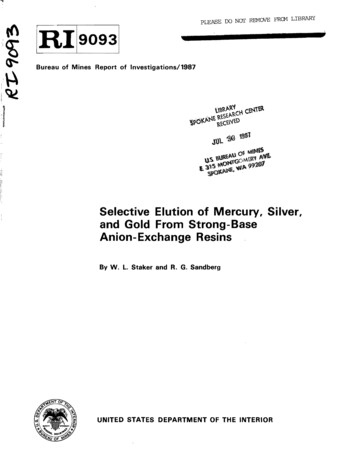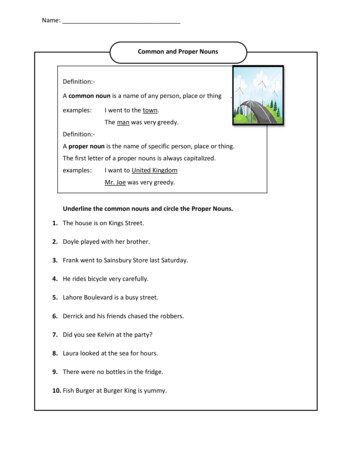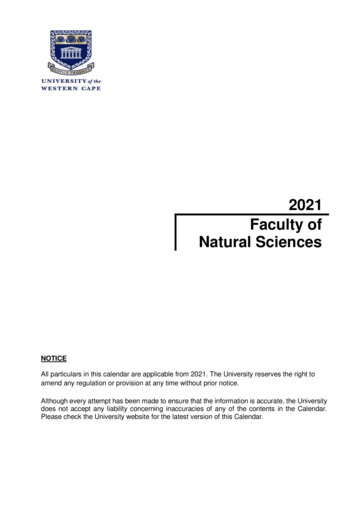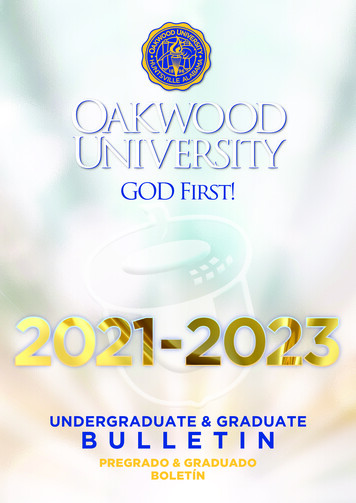
Transcription
FacultyAchieving Proper Centration and Alignment for VisionCorrection in Intraocular and Keratorefractive SurgeryASCRS and ASOA Symposium and Congress George O. Waring, IV, M.D.- Storm Eye InstituteNew Orleans 2016- Medical University of South Carolina- Magill Vision CenterMt Pleasant, SCDaniel H. Chang, M.D.George O. Waring, IV, M.D.John P. Berdahl, MDEmpire Eye & Laser CenterBakersfield, CAStorm Eye Institute / Magill Vision CenterMedical University of South CarolinaMt Pleasant, SCVance Thompson VisionSioux Falls, SD Financial Disclosure Accelerated Vision, AcuFocus, Inc., Alcon,Allergan, AMO, Bausch & Lomb, CXL USA,RevitalVision, FocalPoint, Asia, Gerson LehrmanBiomedical Council, Riechert, SRD Vision,VisiometricsMonday, May 9, 20161Faculty2Faculty John P. Berdahl, M.D. Michael Greenwood, M.D.- Vance Thompson VisionSioux Falls, SD- Vance Thompson VisionSioux Falls, SD- University of South Dakota School of Medicine Financial Disclosure- No financial interests Financial Disclosure- Alcon, Allergan, AMO, Avedro, Bausch and Lomb,Clarvista, Digisight, Envisia, Equinox, Glaukos, NewWorld Medical, Omega Ophthalmics, Ocular SurgicalData, Ocular Therapeutix, Vision 5, Vittamed34
FacultyCourse Outline Introduction (Chang)- Importance of centration andalignment Daniel H. Chang, M.D.- Empire Eye and Laser CenterBakersfield, CA- Ocular axes and angles- Purkinje images Centering and aligningkeratorefractive procedures Financial Disclosure- Abbott Medical Optics, Allergan, Carl Zeiss Meditec,ClarVista Medical, Mynosys Cellular Devices, OmegaOphthalmics, Rapid Pathogen Screening Centering and aligningintraocular procedures- Diffractive and Toric IOLs (Chang)- Toric IOL re-alignment (Berdahl) Discussion / Conclusion- Laser Vision Correction (Waring)- Corneal inlays (Waring)56IOL CentrationIntroduction Good centration importantImportance of centration and alignment- Maximize visual quality- Minimize visual side-effects Aspheric IOLs- Advantage lost when 0.8 mm decentration Diffractive multifocal IOLsIntraoperative- Effects not yet quantified- “Scapegoat” to explain why some patients with goodSnellen VA are unhappyPostoperative78
IOL CentrationDefinitionIntroduction Laboratory studiesOcular Axes and Angles- Optical center or pupil (dilated) center- Scheimpflug or Purkinje devices to find IOL center Clinical observation- Monofocal IOLs Edge not seen in pupil- Multifocal IOLs Pupil centerDecentered Multifocal IOL- Rings concentric with pupil* What about visual axis?9Ocular AxesOcular Axes and Angles Ocular Axes10Optical Axis Ocular Angles- Optical Axis- Angle α (alpha) Alignment of all 3 Purkinje images- Pupillary Axis Optical Axis to Visual AxisOptical Axis- Angle κ (kappa) Pupil center / orthogonal to cornea Pupillary Axis to Line of Sight Originally: Pupillary Axis to Visual Axis- Line of Sight Pupil center to fixation pointFixationPoint- Angle λ (lambda)PIVPIPIII* Pupillary Axis to Line of Sight- Visual Axis Nodal point to fixation point Less commonly used than angle κAlignment of all 3 Purkinje imagesEye model / research definitions werenot intended for intraocular surgery use.1112
Ocular AxesOcular AxesOptical AxisPupillary AxisOptical FixationPoint**Pupil center / orthogonal to corneaUndefined with lens / IOL tilt or decentration(Purkinje images do not align)13Ocular Axes14Ocular AxesPupillary AxisPupillary AxisFixationPointLine of SightPupilCenterPupilCenterFixationPoint**Line of SightFoveaPupil center to fixation pointChanges with pupil centroid shift(Can occur with dilation)1516
Ocular AxesOcular AxesLine of SightVisual e of Sight*Visual AxisNodalPointFoveaCornealVertexNodal point to fixation pointChanges with pupil centroid shift(Can occur with dilation)17Ocular Axes18Ocular AxesVisual AxisAngle αHas been defined as0, 1, or 2 Nodal PointsOptical AxisPIVFixationPoint*N N’Visual AxisNodalPointFixationPointFoveaAngle α* Visual AxisPIPIIINodalPointFoveaOptical Axis to Visual AxisWhere is the nodal point?Theoretical concept in paraxial eye model1920
Ocular AxesOcular AxesAngle κ (original definition)PupillaryFixationPointAngle λ / Angle κ (new definition)PupillaryPupilCenterAxisAngle κ* Visual AxisFixationPointNodalPointPupillary Axis to Visual AxisAxisPupilCenterAngle κ (or λ)*Line of SightPupillary Axis to Line of Sight21Chang DH, Waring IV GO, The Subject-Fixated Coaxially Sighted Corneal Light Reflex: a ClinicalMarker for Centration of Refractive Treatments and Devices. Am J Ophthalmol. 2014;158:863-74.2322Chang DH, Waring IV GO, The Subject-Fixated Coaxially Sighted Corneal Light Reflex: a ClinicalMarker for Centration of Refractive Treatments and Devices. Am J Ophthalmol. 2014;158:863-74.24
Ocular AxesOcular Axes and AnglesFoveal Fixation AxisProblems with Application Cannot be defined in some (all?) eyes- Somewhat useful to communicate conceptsLine that connectsthe Fovea and the Fixation Point How to translate into clinical and surgical practice- How do we find the visual axis or pupillary axis on a real eye?FixationPoint- What about pupil centroid shifting?*Foveal Fixation Axis (FFA)FoveaCornealVertex*In concept onlyUnless there is perfect alignment of all 4 refractivesurfaces, no light ray goes unbent25Ocular Landmarks for Positional Reference26Ocular Landmarks for Positional ReferenceNeedsCandidates Feasibility in identification (of landmarks) Pupil (center) Precision in definition Purkinje images- May need additional qualifications Limbus (center) Lighting conditions Anatomical apexes Viewing / light source arrangement Fixation Consistency in usageWe need a consistentlyregistered coordinate system2728
Ocular Landmarks for Positional ReferenceOcular Landmarks for Positional ReferencePupil CenterPurkinje ImagesNeed to specifylighting conditionPhotopicScotopicIntraoperative29Need to specifyfixationPostoperative30Purkinje ImagesOcular Landmarks for Positional Reference Reflections from the light-transmitting interfaces Four Purkinje reflectionsPurkinje Images- PI: anterior cornea- PII: posterior cornea- PIII: anterior lens/IOL- PIV: posterior lens/IOLPIIIPI / PIIPIVTecnis MultifocalAcrysof IQ ReSTORCrystalens Five-0ZMB00SN6AD1AT50SE3132
Purkinje Images: PIPurkinje Images: PI PI: Reflection from anterior corneal surface- Corneal light reflex Intraoperative appearance Air / anterior cornea (tear film)- Depends on microscope lightconfiguration Bright, upright image- Applications Zeiss Opmi Lumera has threelights Keratometry- Broad illumination beam Corneal topography /Video keratoscopy Commercial eye trackingapplicationsPhakic- Stereo coaxial illumination (SCI)Corneal Light Reflex- Unaffected by surgicalinstrumentationVideo keratoscopy- Altered by shape of corneaAphakic3334Purkinje Images: PIIPurkinje Images: PIII PII: Reflection from posterior corneal surface PIII: Reflection from anterior lens / IOL surface- Specular reflection- Not seen in phakic eyesPIII Posterior cornea : aqueous Aqueous : anterior lens / IOL Dim, upright image Variable brightness, typically upright- Can be seen intraoperatively with air in the AC- Depends on IOL power- Fringing with diffractive rings- Application- “Cat’s eye reflex” Specular microscopy High index materials Flat anterior IOL curvaturePosterior Diffractive RingsAnterior Diffractive RingsSpecular Microscopy3536
Purkinje Images: PIV PIV: Reflection from posterior lens / IOL surface- Faintly visible in some phakic eyesPIV Posterior IOL : aqueous / capsule / vitreous Variable brightness, typicallyinverted- Depends on IOL power- Fringing with diffractive rings- Stretched by toric surface- Affected by IOL chromophorePosterior Diffractive RingsAnterior Diffractive Rings3738Z-axisPIV PIPIV PIPIIIPIVPIIICorneaPIIOL39PIII40
Centration)and)Keratorefractive)SurgeryPurkinje VCornea,anterior surfaceCornea,posterior surfaceLens/IOL,anterior surfaceLens/IOL,posterior surfaceSeen ClinicallyYesRarelyYesYesImage LocationAnterior lens/IOL—Anterior vitreousCorneal �Dim to very brightMedium to brightOrientation*Upright—Upright (usually)Inverted leasant,)SC)*PIII and PIV dependent on IOL Economic ):51P62.Source: CIA World Factbook for Population/Age & Market Scope2Waring)IV,)GO
)GOCentration)guidance)systemInlay)Placement Target)inlay)placement)over)the)1st)Purkinje) ween) hin&300µns&from)desired)positionWaring)IV,)GO
PrePOp)Purkinje)Results Provided)centration)planning)metrics:)– Purkinje&vs&Pupil&Cord&Length&(μm))– Purkinje&vs&Pupil&Angle&(degree))– PostPOp)Purkinje)Results Provided achieved centration metrics:– Purkinje vs Pupil Cord Length(μm)– Purkinje vs Pupil Angle (degree)– Purkinje vs Pupil (x/y distance inμm, direction)– Inlay vs Pupil (x/y distance in μm)– Inlay vs Purkinje (x/y distance pAfter)RecentrationDay)1)PostPOp)20/25,)J3Inlay Location511 microns temporal98 microns superiorInlay Location9 microns temporal90 microns superiorWaring)IV,)GOInlay Location511 microns temporal98 microns superiorInlay Location9 microns temporal90 microns superiorWaring)IV,)GO
Case)1:)Centration)Planning yPrePOp)Data:)1) Purkinje&vs&Pupil:) P375μm)(x)) P219μm)(y))2) Cord&Length:&435μm) xCORD&LENGTH&435μmPUPIL&CENTER1) Purkinje&vs&Pupil:) 110μm)(x)) 50μm)(y))2) E&300μmPURKINJE&VS&PUPIL& Y375μm&(X)& Y219μm&(Y)0μm)(x))0μm)(y) yPrePOp)Data:)ODInlay)Placement)Target:)1) Inlay&vs&Pupil:& P186μm)(x)) P110μm)(y))2) Inlay&vs&Purkinje:& 186μm)(x)) ay)Placement:)1) Inlay&vs&Pupil:& 110μm)(x)) 50μm)(y))2) Inlay&vs&Purkinje:& 0μm)(x)) 0μm)(y))OSPURKINJE&VS&PUPIL& 110μm&(X)& 50μm&(Y) orrectionCourtesy,of,Ray,ApplgegateWaring)IV,)GO
Thank&YouSummary refractive)surgery) natomy)aids)in)successful)placement)– Similar)to)planning)with)topography) New)diagnostic)and)intraoperative)technology) ww.georgewaringiv.com– LVC) Presbylasik)– MFIOLsWaring)IV,)GOIdentifying Ocular Axes: ClinicalUse Purkinje ImagesCentering and aligningintraocular proceduresPupil CenterDiffractive Multifocal IOLsSubject FixatedCoaxially SightedCorneal LightReflex4243
Identifying Ocular Axes: Clinical2D projection 2D anterior segment imaging- Precise X-Y axis information- No depth (Z-axis) information- Pupillary axis and Line of sightare represented as samecoordinate on the imageThe Corneal Light ReflexesBut are they?Chang DH, Waring IV GO, The Subject-Fixated Coaxially Sighted Corneal Light Reflex: a ClinicalMarker for Centration of Refractive Treatments and Devices. Am J Ophthalmol. 2014;158:863-74.44Ocular Landmarks for Positional Reference45Ocular Landmarks for Positional Reference2D projectionPupillaryFixationPoint2D projectionAxisPupillaryPupilCenterAngle κ*Foveal-Fixation lCenterLine of Sight*?Foveal-Fixation AxisClinical / Surgical ViewFoveaCornealVertex(CSCLR)Line of Sight is most accuratedescriptor of pupil location butconnotes the wrong concept.Where is the systembeing viewed from?4647
Ocular Landmarks for Positional ReferenceOcular Landmarks for Positional ReferenceSF-CSCLR AxisSF-CSCLR Axis and TiltThe Subject-Fixated CoaxiallySighted Corneal Light Reflex(SF-CSCLR) AxisFixationPoint*SF-CSCLR AxisNow that we have an axis, wecan begin to study tilt.SF-CSCLR?FixationPointFovea*SF-CSCLR AxisSF-CSCLR?FoveaThe SF-CSCLR / SF-CSCLR axiscould serve as the reference pointfor centration and tilt48Ocular Landmarks for Positional Reference49Ocular Landmarks for Positional ReferenceSF-CSCLR AxisChord mu (µ) Instead of an angle, the distance between SF-CSCLR and Pupil Centeris chord displacement Specify as a vector- From SF-CSCLR to Pupil CenterFixationPoint- DistanceLine of Sight*SF-CSCLR AxisSF-CSCLR?- AngleFovea Specify lighting conditions / dilation statusDisplacement between SF-CSCLRand Pupil Center is now defined!5051
Ocular Landmarks for Positional ReferenceIdentifying Ocular Axes: ClinicalChord mu (µ)Use Purkinje ImagesPupil Center Pupillary AxisorLine of SightSubject FixatedCoaxially SightedCorneal LightReflexSmall chord mu (µ)0.09 mm52Clinical Markers for Centration and ternate NameLine from Fovea toFixation pointVisual AxisFFA—Subject-Fixated Coaxially SightedCorneal Light Reflex—Corneal VertexSF-CSCLRChang-Waring Reflex /CW ReflexSubject-Fixated Coaxially SightedCorneal Light Reflex AxisLine from SF-CSCLR toFixation Point—SF-CSCLR AxisChang-Waring Axis /CW AxisChord muLine from SF-CSCLR toPupil CenterAngle KChord µChang-Waring Chord /CW ChordFoveal-Fixation AxisChang DH, Waring IV GO. Am J Ophthalmol. 2014;158:863-74.Buehren T. Am J Ophthalmol. 2015;159(3):611-2. Chang DH, Waring IV GO. Am J Ophthalmol. 2015;159(3):612.Visual AxisorFoveal Fixation AxisLarge chord mu (µ)0.46 mm53Clinical Markers for Centration and AlignmentDefinitionName Corneal Vertex 54Zeiss IOLMaster 70055
Identifying Ocular Axes: SurgicalOcular Axes and CentrationUse Purkinje ImagesPupilCenterSF-CSCLRNSmall CW-ChordLarge CW-ChordNN*TOptical AxisTSF-CSCLR Axis FFATCW-Chord0.09 mm0.31 mm0.37 mm0.46 mmPupil CenterSF-CSCLRNeitherLine of Sight / Pupillary AxisIOL Centration5657Ocular Axes and CentrationIntraoperative IOL Positioning Optically IOL position can be adjusted- Best to center on SF-CSCLR Axis / FFA 45 to 60 - Can primarily be moved in directionperpendicular to area of peripheralbag-haptic contact- Hyperopic LASIK- Eye model studies- Depends on IOL material and design Cosmetically Tecnis Multifocal 1-Piece IOL- “Looks better” to center on pupillary axis- Hydrophobic acrylic- Pupil easy to see intraoperatively- Modified C loop haptics11 mmbag13 mmIOL Reference for capsulotomy creation- Easy to see at slit lamp postoperativelyDirection of best movement is 30 to 45 clockwise from (to theright of) haptic insertionSF-CSCSR Axis / FFA centration provides best visual outcomesTecnis Multifocal 1-Piece IOL5859
Intraoperative IOL PositioningIntraoperative IOL PositioningVector ForcesIOL Shifted to Left“Centered” in bagIOL Shifted to RightSlight distention of bag counteracts inward force vectors.6061Intraoperative IOL PositioningIntraoperative IOL PositioningCorrelation to Postoperative Change in IOL position- From Intraoperative to Postoperative (n 18) R 0.91Postop IOL Position (mm)0.60.40.20-0.2-0.4-0.6Initial IOL PositionFinal IOL Position-0.6-0.4-0.200.20.40.6Intraop IOL Position (mm)62Chang DH. Centering diffractive multifocal IOLs with intraoperative use of Purkinje images. Presented at Refractive Surgery Subspecialty Day 2011. Orlando, FL.63
Centration StabilityCentering and aligningintraocular procedures Excellent centration stability over time- Compared to POD 1- One-piece Tecnis Multifocal IOLToric IOLsPosition Change (Compared to Day 1) of IOL Center Relative to: 2 months2-4 months4-6 months6-12 monthsRelative to Corneal vertexMean change inIOL position (mm)Correlation (R)0.10 0.060.09 0.070.08 0.070.10 0.070.750.930.970.98Relative to Pupil centerMean change inIOL position (mm)Correlation (R)0.15 0.090.14 0.050.18 0.070.13 0.050.850.880.880.92Chang DH. Centration stability of a one-piece aspheric diffractive multifocal IOL. Poster at the ARVO Annual Meeting, Ft. Lauderdale, FL. 2012.64Aligning Toric IOLs65Alignment Begins with CentrationRotational alignment is important180 180 0 0 Misalignment at 6 Realignment at 175 Hands must be centered to align correctlywww.astigmatismfix.com6667
Alignment Begins with CentrationAlignment Begins with CentrationOS: 18.5 ZCT150 @ 090IOL must be centered to align correctlyOS: 24.0 ZCT300 @ 08068Alignment Begins with CentrationWhere is the center?69Alignment Begins with CentrationOS: 28.0 ZCT400 @ 120Where is the center?7071
Centering and Aligning Toric IOLs Center IOL on the (SF-CSCLR)Residual Astigmatism after Toric IOL – Nowwhat? Rotate IOL to be parallel to corneal marks Must align all 5 points:- SF-CSCLR- Toric marks on both sides of IOL- Both peripheral corneal marksJohn Berdahl M.D.72Residual AstigmatismCauses of Residual AstigmatismWrong LocationPOM #1 SN6AT9 Toric IOL @ 110 Vasc 20/60MRX – -1.00 1.75 x 150 20/25Wrong LensWrong EyePoor MeasurementsPoor MeasurementsOcular Surface DiseasePoor CalculationsSurprising SIAPosterior KsIOL RotatedPoor IOL PlacementPoor CalculationsSurprising SIAPosterior KsABMDIrregular AstigmatismTreat Disease
Causes of Residual AstigmatismWrong LocationWrong LensCauses of Residual AstigmatismWrong LocationWrong LensPoor MeasurementsPoor MeasurementsPoor MeasurementsPoor MeasurementsPoor CalculationsSurprising SIAPosterior KsIOL RotatedPoor IOL PlacementPoor CalculationsSurprising SIAPosterior KsPoor CalculationsSurprising SIAPosterior KsIOL RotatedPoor IOL PlacementPoor CalculationsSurprising SIAPosterior KsCauses of Residual AstigmatismWrong LocationWrong LensCauses of Residual AstigmatismWrong LocationWrong LensPoor MeasurementsPoor MeasurementsPoor MeasurementsPoor MeasurementsPoor CalculationsSurprising SIAPosterior KsIOL RotatedPoor IOL PlacementPoor CalculationsSurprising SIAPosterior KsPoor CalculationsSurprising SIAPosterior KsIOL RotatedPoor IOL PlacementPoor CalculationsSurprising SIAPosterior KsSurgically induced Astigmatism
Toric IOL MisalignmentCauses of Residual AstigmatismWrong LocationWrong LensPoor MeasurementsPoor CalculationsSurprising SIAPosterior KsIOL RotatedPoor IOL PlacementRotate IOLIdeal Axis of Toric IOLActual Axis of Toric IOLPoor MeasurementsWill RotatingIOL Help?Poor CalculationsSurprising SIAPosterior KsIOL Xchange or LVCToric Misalignment of T90 5 10 15
Math Frowns on MisalignmentIOL MisalignmentMisalignment% Loss0deg5⁰ misalignment 0.4% loss of powerAbsolute LossT3 (1.03D)T9 15deg50%0.51D2.0530deg100%1.03D4.11D5⁰ misalignment 17% loss of powerResidual AstigmatismActual Axisof Toric IOLPOM #1 SN6AT9 Toric IOL @ 110 Ideal Axis ofToric IOLVasc 20/60MRX – -1.00 1.75 x 150 20/25Rotate IOL 10 CCWPrior MRX -1.00 1.75 x 150Predicted MRX -0.29 0.32 x 150www.astigmatismfix.com
Mark Current and Ideal AxisBefore Rotation-1.00 1.75 x 150Filtering CriteriaCharacteristicTotal Entries:Patient Eye16,683OriginalCalculated IOL AxiseringCurrent SphereFil tplano 0.50 x 112Vasc 20/20EffectivenessValueLeft Eye; Right EyeAstigmatism Prior to Rotation: 1.83 D0 to 180 Current Axis of Astigmatism-6D to 6Dgotalin0.5DSubtto 10D0 to 180 IOL Cylinder Power0D to 10DCurrent IOL Axis0 to 180 IOL TypeNot Selected; SN6AT3; SN6AT4; SN6AT5; SN6AT6; SN6AT7;SN6AT8; SN6AT9; Staar2.0; Staar3.5; ZCT225; ZCT300; ZCT400;BL1UT125; BL1UT200; BL1UT27511,474Current Cylinder (plus power)Vasc 20/60After Rotation5,475isd AxendetnIWith2,7450.93D corrected(51% Reduction)Astigmatism After Rotation: 0.90 D
Causes of Residual AstigmatismActual Axis of IOL1.) Change in Ideal Axis*-76% (2091)Possible Causes: Inaccurate measurements/calculations Inaccurate cyclotorsionmeasurement1Ideal Axis of IOL SIA2 Posterior Corneal Astigmatism3 Unstable Astigmatism (underlyingdisease)* 5 of change/rotation[n 2745]1.Tjon-Fo-Sang MJ, de Faber J-THN, Kingma C, Beekhuis WH. Cyclotorsion: A possible cause of residual astigmatism in refractivesurgery.2.Hill W. Expected effects of surgically induced astigmatism on AcrySof toric intraocular lens results.3.Koch DD, Ali SF, Weikert MP, Shirayama M, Jenkins R, Wang L. Contribution of posterior corneal astigmatism to total cornealastigmatismCauses of Residual AstigmatismChange in Ideal Axis24%76%Neither6%Causes of Residual AstigmatismOriginal Axis of IOL2.) IOL Rotation*-70% (1912)Current Axis of IOL* 5 of change/rotation[n 2745]Rotation Direction(of IOLs that rotated 5 [n 1904] )IOL Rotation52%18%70% Clockwise: 38% (729) CCW: 62% (1175)
Residual Astigmatism #2Mean: 20.8 Median: 22.8 POW#1 SN6AT9 Toric IOL @ 158 Vasc 20/70MRX – -1.75 3.50 x 092 20/25[n 2745]Ideal Axis ofToric IOL
ORA ScreenshotsBefore Rotation-1.75 3.50 x 92Vasc 20/70Step By StepBy the way .1.2.3.4.5.6.7.8.9.10.Measure MRXMeasure IOL Axis and know its toricityPlug info to Astigmatismfix.comDoes Rotating IOL Neutralize Astigmatism?Is Spherical Equivalent Acceptable?Can IOL be Easily Rotated?Mark Current and Ideal AxisLoosen IOL with ViscoelasticRotate IOLRemove ViscoelasticAfter RotationPlanoVasc 20/20
SummaryAn ounce of prevention .Mark in upright positionUse multiple confirmatory K SourcesIntraoperative Alignment can helpUse intraoperative aberrometry Know SIA,including how it affects the axisRotate IOLLaser Vision CorrectionS.E. near targetAstigmatism NeutralizableS.E. not at targetAstigmatism not neutralizableIOL cannot be rotated easilyFinal ThoughtMuch more important with higher powered toricIOLs and toric multifocals-Might be eliminated with the Calhoun LightAdjustable LensThankORangeyou
Discussion / ConclusionsCentration and Alignment73
Vance Thompson Vision Sioux Falls, SD Daniel H. Chang, M.D. Empire Eye & Laser Center Bakersfield, CA Monday, May 9, 2016 Faculty George O. Waring, IV, M.D. -Storm Eye Institute -Medical University of South Carolina -Magill Vision Center Mt Pleasant, SC Financial Disclosure Accelerated Vision, AcuFocus, Inc., Alcon,










